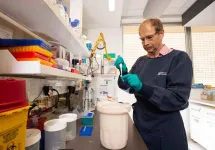(Press-News.org) Promising new research suggests a total of just 4.5 minutes of vigorous activity that makes you huff and puff during daily tasks could reduce the risk of some cancers by up to 32 percent.
Published in JAMA Oncology and led by the University of Sydney, Australia, the study used data from wearable devices to track the daily activity of over 22,000 ‘non-exercisers’. Researchers then followed the group’s clinical health records for close to seven years to monitor for cancer.
As few as four to five minutes of vigorous intermittent lifestyle physical activity or ‘VILPA’ was associated with a substantially lower cancer risk compared to those who undertook no VILPA.
Vigorous Intermittent Lifestyle Physical Activity, or VILPA for short, was coined by researchers at the University of Sydney’s Charles Perkins Centre to describe the very short bursts of activity—around one minute each—we do with gusto each day. This includes activities like vigorous housework, carrying heavy shopping around the grocery store, bursts of power walking or playing high-energy games with the kids.
“VILPA is a bit like applying the principles of High-Intensity Interval Training (HIIT) to your everyday life,” said lead author Professor Emmanuel Stamatakis of the Charles Perkins Centre.
He said adults who don’t exercise are at increased risk of developing certain cancers like breast, endometrial or colon, but until recently the impact of less structured forms of vigorous physical activity was unable to be measured.
“We know the majority of middle-aged people don’t regularly exercise which puts them at increased cancer risk but it’s only through the advent of wearable technology like activity trackers that we are able to look at the impact of short bursts of incidental physical activity done as part of daily living,” said first author Professor Stamatakis.
“It’s quite remarkable to see that upping the intensity of daily tasks for as little as four to five minutes a day, done in short bursts of around one minute each, is linked to an overall reduction in cancer risk by up to 18 percent, and up to 32 percent for cancer types linked to physical activity.”
The study is observational, meaning it isn’t designed to directly explore cause and effect. However, the researchers say they are seeing a strong link and refer to previous early-stage trials showing that intermittent vigorous physical activity leads to rapid improvements in cardio-respiratory fitness, which may provide a possible biological explanation for reduced cancer risk. Other likely contributors include physical activity’s role in improving insulin sensitivity and chronic inflammation.
“We need to further investigate this link through robust trials, but it appears that VILPA may be a promising cost-free recommendation for lowering cancer risk in people who find structured exercise difficult or unappealing,” says Professor Stamatakis.
The international research team includes investigators from the University of Sydney (Australia), University College London (UK), Harvard Medical School (US), University of Calgary (Canada), Maastricht University (The Netherlands), National Research Centre for the Working Environment (Denmark), The University of East Anglia (UK), Norwegian University of Science and Technology (Norway), Loughborough University (UK), and University of Adger (Norway).
What did the researchers find?
In a study sample of 22,398 people with an average age of 62 who didn’t exercise in their leisure time, the researchers found;
2356 new cancer events (1084 in physical activity related cancer) over an average follow-up of 6.7 years
a minimum of around 3.5mins of daily VILPA was associated with up to 18 percent reduction in cancer incidence (compared with no VILPA)
4.5 mins of daily VILPA was associated with up to 32 percent reduction in physical activity-related cancer incidence
the steepest gains in cancer risk reduction were seen in people who did small amounts of VILPA compared to those who did none, however, benefits continued with higher levels of daily VILPA - particularly for physical activity-related cancers
most VILPA (92 percent) occurred in bouts of up to 1min.
Study design
The current study analysed the impact of VILPA on overall cancer incidence, as well as for 13 cancer sites associated with physical activity; these include liver, lung, kidney, gastric cardia (a type of stomach cancer), endometrial, myeloid leukaemia, myeloma, colorectal, head and neck, bladder, breast and esophageal adenocarcinoma (cancer of the oesophagus).
The researchers used data from the UK Biobank Accelerometry Sub Study and only included those who identified as ‘non-exercisers’ – meaning they self-reported no leisure time exercise and no regular recreational walks.
They excluded study participants that could skew the results including due to previous cancer diagnosis or diagnosis within a year of enrolment. Other influences such as age, smoking status, BMI, cardiovascular disease, sleep, diet and hereditary cancer risk were also taken into account.
VILPA was assessed based on the participant’s activity levels as measured by wrist accelerometers worn over 7 days at study onset. This is consistent with other wearable studies as physical activity levels remain relatively stable at the population level over adulthood.
New cancer events were recorded via cancer registries, and hospitalisations or deaths attributable to cancer.
Next steps
“We are just starting to glimpse the potential of wearable technology to track physical activity and understand how unexplored aspects of our lives affect our long-term health – the potential impact on cancer prevention and a host of other health outcomes is enormous,” said Professor Stamatakis.
END
Short bursts of daily activity linked to reduced cancer risk
Wearable technology reveals potential benefits of vigorous incidental activity
2023-07-27
ELSE PRESS RELEASES FROM THIS DATE:
Johns Hopkins Applied Physics Laboratory restores cold sensation in amputees’ phantom limbs
2023-07-27
Johns Hopkins Applied Physics Laboratory (APL) researchers have developed one of the world’s smallest, most intense and fastest refrigeration devices, the wearable thin-film thermoelectric cooler (TFTEC), and teamed with neuroscientists to help amputees perceive a sense of temperature with their phantom limbs. This advancement, one of the first of its kind, enables a useful new capability for a variety of applications, including improved prostheses, haptics for new modalities in augmented reality (AR) and thermally-modulated therapeutics for applications such as pain management. The technology also has a variety ...
New resource harmonizes 16S and shotgun sequencing data for microbiome research
2023-07-27
Two leading sequencing techniques are no longer at odds, thanks to an international effort led by scientists at University of California San Diego. In a study published July 27, 2023 in Nature Biotechnology, the researchers debuted a new reference database called Greengenes2, which makes it possible to compare and combine microbiome data derived from either 16S ribosomal RNA gene amplicon (16S) or shotgun metagenomics sequencing techniques.
“This is a significant moment in microbiome research, as we’ve effectively rescued over a decade’s worth of 16S data that might have otherwise become obsolete in the modern world ...
Preventing weight gain: Yo-yo no-go zones for Australians
2023-07-27
There’s no doubt that Aussies love a good celebration. We’re all in when it comes to the weekend, and most of us can’t go past a Christmas celebration without a little bit of overindulging. But all this comes at a cost, and it’s taking a massive toll on our waistline.
Now, a world-first study from the University of South Australia exposes the real weight gains of everyday Australians, in a move to tackle overweight and obesity.
Funded by the NHMRC, and published in JAMA Open Network today, the study explored how weight changes across a 12-month period, finding that weight fluctuated throughout the year.
Specifically, ...
Closing cancer cell’s escape route
2023-07-27
Chemotherapy and radiotherapy aim to destroy cancer cells by inducing DNA double-strand breaks – damage that, once inflicted, usually causes the cells to die. But damage to a cell’s genetic material also activates a signaling pathway called IKK/NF-κB that helps prevent cell death, thus limiting the success of these treatments in patients.
NF-κB is a family of gene regulators that controls a wide variety of cellular processes – from immune responses to embryonic development – and is activated by the enzyme complex ...
Fiber-infused ink enables 3D-printed heart muscle to beat
2023-07-27
Over the last decade, advances in 3D printing have unlocked new possibilities for bioengineers to build heart tissues and structures. Their goals include creating better in vitro platforms for discovering new therapeutics for heart disease, the leading cause of death in the United States, responsible for about one in every five deaths nationally, and using 3D-printed cardiac tissues to evaluate which treatments might work best in individual patients. A more distant aim is to fabricate implantable tissues that can heal or replace faulty or diseased structures inside a patient’s heart.
In a paper published in Nature Materials, researchers ...
New technology promises rapid and reliable development of new diagnostic tests
2023-07-27
QUT researchers have developed a new approach for designing molecular ON-OFF switches based on proteins which can be used in a multitude of biotechnological, biomedical and bioengineering applications.
The research team demonstrated that this novel approach allows them to design and build faster and more accurate diagnostic tests for detecting diseases, monitoring water quality and detecting environmental pollutants.
Professor Kirill Alexandrov, of the QUT School of Biology and Environmental ...
Jinghui Zhang, Ph.D., elected Fellow of the International Society for Computational Biology
2023-07-27
(Memphis, Tenn. – July 27, 2023) St. Jude Children’s Research Hospital proudly announces that Jinghui Zhang, Ph.D., Member of the Department of Computational Biology, has been elected as a Fellow of the International Society for Computational Biology.
Zhang is one of 15 scientists given this distinction in 2023. She’s being honored for the development and application of innovative computational methods, discovering novel targets and accelerating research and genomic data sharing to advance the diagnosis, treatment and surveillance of pediatric cancers and survivors.
“I ...
Motivation and pleasure deficits play important role in social functioning across psychiatric disorders
2023-07-27
Dr. Raymond Chan's team from the Institute of Psychology of the Chinese Academy of Sciences and his collaborators have recently shown that amotivation and anhedonia, rather than expressive dysfunction, play a crucial role in determining the social functioning of schizophrenia patients.
The study was published in Nature Mental Health.
Negative symptoms refer to the loss of normal functioning, including anhedonia, avolition, alogia, asociality, and affective blunting, and have been shown to be the most important predictors ...
Storing fat at the waist may NOT up diabetes risk, surprise findings indicate
2023-07-27
Conventional wisdom holds that storing fat around your belly puts you at increased risk for type 2 diabetes. But surprising new findings from the University of Virginia School of Medicine suggest that naturally occurring variations in our genes can lead some people to store fat at the waist but also protect them from diabetes.
The unexpected discovery provides a more nuanced view of the role of obesity in diabetes and related health conditions. It also could pave the way for more personalized medicine – treatments tailored to the individual. ...
Using cosmic weather to study which worlds could support life
2023-07-27
COLUMBUS, Ohio – As the next generation of giant, high-powered observatories begin to come online, a new study suggests that their instruments may offer scientists an unparalleled opportunity to discern what weather may be like on far-away exoplanets.
Dubbed the extremely large telescopes (ELTs), these observatories, which include the Extremely Large Telescope (ELT), the Giant Magellan Telescope (GMT), and the Thirty Meter Telescope (TMT), will be some of the largest ground-based telescopes ever built, and their instruments are expected to exceed ...
LAST 30 PRESS RELEASES:
Discovery reveals how keto diet can prevent seizures when drugs fail
JMIR Publications and Sikt announce pilot flat-fee unlimited open access partnership
Finding new cell markers to track the most aggressive breast cancer in blood
A new, cleaner way to make this common fertilizer
Fire-safe all-solid-state batteries move closer to commercialization
Disinfecting drinking water produces potentially toxic byproducts — new AI model is helping to identify them
Unplanned cesarean deliveries linked to higher risk of acute psychological stress after childbirth
Healthy aging 2026: fresh pork in plant-forward diets supported strength and brain-health biomarkers in older adults
Scientists identify pre-cancerous states in seemingly normal aging tissues
Itaconate modifications: mechanisms and applications
Potential tumor-suppressing gene identified in pancreatic cancer
Winners of the 2026 Hill Prizes announced
Autonomous AI agents developed to detect early signs of cognitive decline
Study finds ocean impacts nearly double economic cost of climate change
Increased deciduous tree dominance reduces wildfire carbon losses in boreal forests
Researchers discover how a respiratory bacterium obtains essential lipids from the human body and targets fat-rich tissues
Locust swarms destroy crops. Scientists found a way to stop that
More resources and collaboration needed to support prevention and treatment of obesity
Two types of underconfidence linked to anxiety and gender
Insects are victims too: Global study shows impacts of invasive alien species on populations
Pioneering natural, degradable polymer capsules
Forestry is becoming digital and automated
Maternity baby deaths much higher in northern England than in the South
Mosquitoes’ thirst for human blood has increased as biodiversity loss worsens
The stop-smoking medication varenicline may also work for cannabis use disorder
Potential new treatment for sepsis
Study reveals how many hours of video games per week might be too many
Electrospinning for mimicking bioelectric microenvironment in tissue regeneration
Home fingertip oxygen monitors less accurate for people with darker skin tones
Six weeks in a cast no less effective than surgery for unstable ankle fractures
[Press-News.org] Short bursts of daily activity linked to reduced cancer riskWearable technology reveals potential benefits of vigorous incidental activity





